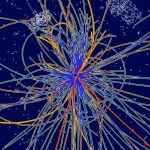
The discovery of anything nicknamed “the God particle” is bound to arouse the curiosity of Christian believers around the world, especially those who are not familiar with the world of particle physics and have never heard of the Higgs boson, which is the name by which the particle is known in the physics community. What is this particle, how did it acquire its nickname, and is there a real sense in which Christians can see the hand of God in the existence of such an exotic entity?
That such a particle should exist was first proposed by the Scottish physicist Peter Higgs in 1964. Actually, Higgs was one of a handful of physicists in the early 1960s who were trying to explain the origin of mass (resistance to acceleration) in terms of a force field that permeates all of space and produces a resistance to motion proportional to the amount of mass possessed by the objects moving through it. In quantum field theory, such force fields are always mediated by a particle called a boson that conveys the force. As Higgs noted in his original paper, this mass-conferring force-field predicted the existence of a new particle of unknown mass. This particle came to be known among physicists as the Higgs boson. It was finally discovered in experiments at a large particle accelerator near Geneva, Switzerland, in July 2012. Its discovery brought to completion the picture of the atomic and subatomic world associated with the Standard Model of particle physics, a theory that has governed our understanding of the microscopic world since its completion as a theoretical structure in the early 1970s. The discovery of the Higgs boson garnered Peter Higgs and another researcher, the Belgian physicist François Englert, the 2013 Nobel Prize in Physics for work they did half a century ago.
But how did the Higgs boson come to be called “the God particle”? The name comes from the title of a 1993 book written by Leon Lederman, erstwhile director of Fermilab, the particle accelerator facility in Batavia, Illinois, just outside of Chicago. As for why he called it “the God particle,” the part of this tale relevant to our purposes rests on the role it plays in modern physics. While Lederman is an atheist and used the term with humorous intent, a closer consideration of the function and properties of the Higgs boson is very enlightening from a theistic perspective.
What the Higgs boson does is give substantiality (push-back, if you like) to the world of our experience. But not only does it do this, thereby explaining how our universe’s laws of motion are possible, it also is necessary for our universe’s habitability. Let me explain. Since Einstein’s special theory of relativity requires massless particles to travel at the speed of light and without the Higgs field no particles would have mass, if there were no Higgs boson, everything would be traveling at the speed of light. Under such conditions no atoms would exist, no chemistry would be possible, and the universe itself would be completely lifeless. In short, along with a handful of other fundamental forces and laws—things like gravity, the nuclear force, electromagnetism, some sort of quantization rule, and the Pauli exclusion principle that enables matter to form structures—the Higgs mechanism is necessary for the existence of life. Without it, we wouldn’t be here.
The necessity of the Higgs mechanism extends beyond its mere existence, however. The mass of the Higgs boson and the strength of the Higgs field also are fine-tuned for the existence of life. If the Higgs did not exist in its predicted mass-energy range, dire consequences would follow. In 1997 it was shown that if the Higgs boson were even five times more massive than the value it is measured to have, it would suppress the formation of all atoms larger than hydrogen, effectively rendering the universe lifeless (http://arxiv.org/abs/hep-ph/9707380v2). Furthermore, experiments at the same facility in Switzerland at which the Higgs was discovered are pointing to the falsity of another conjecture that has played a role in theoretical physics beyond the Standard Model, namely supersymmetry (http://www.scientificamerican.com/article.cfm?id=supersymmetry-fails-test-forcing-physics-seek-new-idea). Supersymmetry is essentially the idea that every force particle (boson) has a partner that is a matter particle (fermion) and vice-versa. If supersymmetry is false, and the consensus for its falsity is growing, then in the absence of supersymmetric cancellations between fermions and bosons that solve the so-called “hierarchy problem” by imposing constraints on the strength of the Higgs field, its field strength has to be fine-tuned to about one part in a trillion quintillion (1 followed by 30 zeros) for the Higgs boson to have its observed mass (http://lifshitz.ucdavis.edu/~santopietro/hierarchyproblem.pdf), a mass that could not differ by even a factor of ten if we are to exist.
Of course, where the fine-tuning of the universe for the existence of life is concerned, these observations about the Higgs boson are just the tip of the iceberg. The amount of fine-tuning present in the forms taken by the laws of nature, the conditions governing the beginning of the universe, and the values associated with various universal constants (force-field strengths, particle masses, etc.) is beyond the reach of any undirected process. The specified nature of these forms, conditions and values, combined with their staggering and (mostly) multiplicative improbabilities, leads inexorably to the conclusion that the universe has these properties as the result of an intelligent cause, not an undirected process. Instead of Nobel Laureate Steven Weinberg’s remark that “the more the universe seems comprehensible, the more it seems pointless,” the evidence points in exactly the opposite direction: the greater our comprehension of the universe, the more we understand it as the precise product of transcendent design. The proper response is one of doxology—the heavens are telling the glory of God (Psalm 19)—not cynical unbelief: “For since the creation of the world God’s invisible qualities—his eternal power and divine nature—have been clearly seen, being understood from what has been made, so that people are without excuse” (Romans 1:20).
